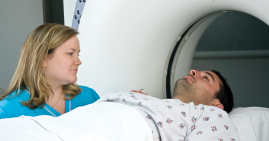 What Are the Risks of Colon Cancer?
What Are the Risks of Colon Cancer?
If you’re turning 50 or have a condition that puts you at a higher than average risk for colon cancer, you’ve probably been told that you should have a colonoscopy. It’s true that colon cancer screening is an important part of preventive health care: the average lifetime risk of developing colon cancer is 5% but can vary widely across demographics. For example, 90% of new cases appear in patients over 50, and those with a parent or sibling who has developed colon cancer face a risk that is two to three times higher than the general population. While the survival rate of colon cancer patients has been rising since the 1980s, the disease remains the second-leading cause of cancer-related death in the U.S.[1]
How Is Colon Cancer Diagnosed?
Symptoms of colon cancer may not appear in the early stages of the disease and can resemble the symptoms of a number of other ailments. Signs such as bowel changes, blood in the stool, abdominal discomfort, bloating, and weight loss are easily overlooked or attributed to other causes. Because colon cancer patients often do not exhibit identifiable signs of the disease until it has progressed, screening that catches cancers at earlier stages is an important part of treating patients as effectively as possible.
While traditional colonoscopy is perhaps the best known method of colon cancer screening, patients have other, less invasive choices available. The American Cancer Society includes “virtual colonoscopy” (also known as CT colonography) in its list of recommended screening methods, and the US Preventive Services Task Force (USPSTF) has recently given the CT colonography a grade of “A,” which holds promise for increasing insurance coverage of this less invasive screening method.
What Is CT Colonography?
Rather than inserting a camera (called an endoscope) into the rectum to observe the condition of the colon, in a virtual colonoscopy, computed tomography (CT) is used to create a three-dimensional image of the colon. As a result, the procedure carries a lower risk of complications for most patients than traditional colonoscopy and, unlike traditional colonoscopy, does not routinely require sedation. Because the observed area isn’t limited to the colon’s interior during a virtual colonoscopy, it can also help doctors identify other abnormalities, such as cancers growing outside the colon or abdominal aortic aneurysms. Note, however, that CT colonography is not recommended for patients who have active inflammatory bowel disease, diverticulitis,or a history of bowel perforation, as these patients may face increased risk from this procedure. [2]
What Should I Expect During a Virtual Colonoscopy?
As with a traditional colonoscopy, you will be asked to follow a specific bowel cleansing regimen prior to your appointment. This is an important step in maximizing the visibility of any polyps that might be present. Be sure to alert your physician if you have heart, liver, or kidney disease so they can prescribe a cleansing regimen that is safe for you.
When you arrive at the clinic, a radiologic technologist will take your medical history. If you experience severe pain or cramps on the day of the examination, be sure to report this, as it may require rescheduling. In the exam room, you will lie on your side on the exam table as a very small, flexible tube is inserted two inches into the rectum, through which carbon dioxide is pumped in order to inflate the colon for clear viewing. This often creates a feeling of fullness and may cause some discomfort similar to naturally occurring gas pains. You will then be asked to lie on your back, and then on your stomach, as images are taken. You may hear slight a slight buzzing and clicking as the machine does its work. The whole procedure takes only about 15 minutes. Afterward, you’re free to resume your usual activities.
What Follow-Up Is Necessary?
If your exam shows no abnormalities, the American Cancer Society recommends repeating the exam in five years. However, a colonoscopy should be performed following any positive results from a CT colonography. According to the American College of Gastroenterology, the callback rate for CT colonography ranges from 12–25%, depending, in part, upon patient age.
Iowa Radiology offers virtual colonoscopy at our Downtown Des Moines clinic. Feel free to contact us for more information. We are dedicated to providing our patients the information and resources they need to make the best possible decisions about their health.
The information contained in the Iowa Radiology website is presented as public service information only. It is not intended to be nor is it a substitute for professional medical advice. You should always seek the advice of your physician or other qualified healthcare provider if you think you may have a medical problem before starting any new treatment, or if you have any questions regarding your medical condition.
Iowa Radiology occasionally supplies links to other web sites as a service to its readers and is not in any way responsible for information provided by other organizations.
[1] “Statistics.” CCAlliance.org. Colon Cancer Alliance, 1 Oct 2015. Web. 28 Oct 2016.
[2] “CT Colonography.” Radiologyinfo.org. American College of Radiology, 19 Oct 2005. Web. 28 Oct 2016.
[3] Ibid.


